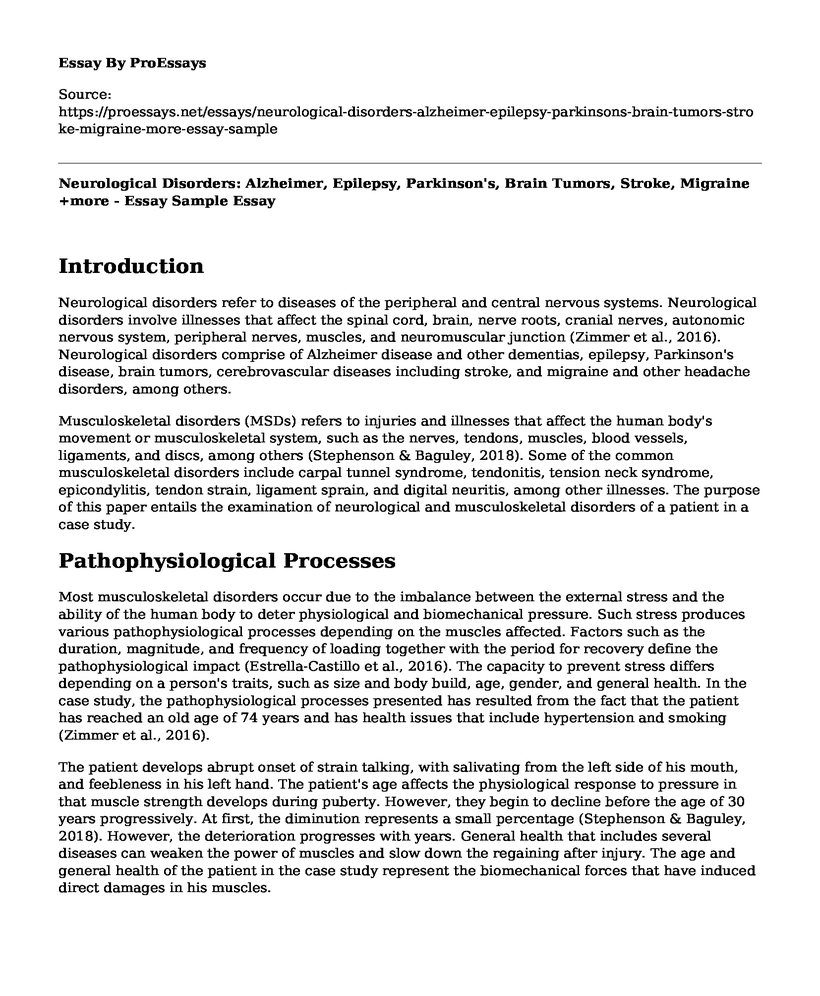Introduction
Neurological disorders refer to diseases of the peripheral and central nervous systems. Neurological disorders involve illnesses that affect the spinal cord, brain, nerve roots, cranial nerves, autonomic nervous system, peripheral nerves, muscles, and neuromuscular junction (Zimmer et al., 2016). Neurological disorders comprise of Alzheimer disease and other dementias, epilepsy, Parkinson's disease, brain tumors, cerebrovascular diseases including stroke, and migraine and other headache disorders, among others.
Musculoskeletal disorders (MSDs) refers to injuries and illnesses that affect the human body's movement or musculoskeletal system, such as the nerves, tendons, muscles, blood vessels, ligaments, and discs, among others (Stephenson & Baguley, 2018). Some of the common musculoskeletal disorders include carpal tunnel syndrome, tendonitis, tension neck syndrome, epicondylitis, tendon strain, ligament sprain, and digital neuritis, among other illnesses. The purpose of this paper entails the examination of neurological and musculoskeletal disorders of a patient in a case study.
Pathophysiological Processes
Most musculoskeletal disorders occur due to the imbalance between the external stress and the ability of the human body to deter physiological and biomechanical pressure. Such stress produces various pathophysiological processes depending on the muscles affected. Factors such as the duration, magnitude, and frequency of loading together with the period for recovery define the pathophysiological impact (Estrella-Castillo et al., 2016). The capacity to prevent stress differs depending on a person's traits, such as size and body build, age, gender, and general health. In the case study, the pathophysiological processes presented has resulted from the fact that the patient has reached an old age of 74 years and has health issues that include hypertension and smoking (Zimmer et al., 2016).
The patient develops abrupt onset of strain talking, with salivating from the left side of his mouth, and feebleness in his left hand. The patient's age affects the physiological response to pressure in that muscle strength develops during puberty. However, they begin to decline before the age of 30 years progressively. At first, the diminution represents a small percentage (Stephenson & Baguley, 2018). However, the deterioration progresses with years. General health that includes several diseases can weaken the power of muscles and slow down the regaining after injury. The age and general health of the patient in the case study represent the biomechanical forces that have induced direct damages in his muscles.
Race/Ethnic Variables in Healthcare
Scientists organize race/ethnic variables in health depending on various factors, such as ancestry, phenotype, social identity, experience, and genetic makeup (Stephenson & Baguley, 2018). However, race/ethnic variables remain homogenous in health research. Epidemiological statistics show that race/ethnic factors remain lopsidedly influenced by diseases, regarding mortality and morbidity (Beatty et al., 2016). Such health variations due to race/ethnic variables generate racial health differences. The health disparities may mean some older people in society remain disadvantaged due to their socioeconomic status (Stephenson & Baguley, 2018). From the case study, the patient displays behavioral risk factors like his history of smoking that relates to racial/ethnic variable that can impact on the physiological functioning.
Besides, the patient exhibits health care behavior as he refuses to admit his suffering or pain to his wife. The patient does not want to receive healthcare, an indication that race/ethnic variables have a role in his unwillingness to accept healthcare. The pathophysiological processes interacted to increase the patient's blood pressure to 178/94, pulse 78, and regular, PaO2 97% on room air (Beatty et al., 2016). Besides, the cranial nerves that relay information to the brain and control some tissues have affected the patient's right arm and leg and interfered with his speech.
Conclusion
Pathophysiological processes may cause inflammation of ligaments and related muscles. Neurological and musculoskeletal disorders can display several symptoms of distress, such as fatigue, pain, muscle feebleness, sensory loss and numbness, stiffness and restrictions of movement, or primary inflammation and enlarged heart due to swelling.
References
Beatty Moody, D. L., Waldstein, S. R., Tobin, J. N., Cassells, A., Schwartz, J. C., & Brondolo, E. (2016). Lifetime racial/ethnic discrimination and ambulatory blood pressure: The moderating effect of age. Health Psychology, 35(4), 333. www.psycnet.apa.org/record/2016-14744-004
Estrella-Castillo, D. F., & Gomez-de-Regil, L. (2016). Quality of life in Mexican patients with primary neurological or musculoskeletal disabilities. Disability and health journal, 9(1), 127-133. www.sciencedirect.com/science/article/pii/S1936657415000837
Stephenson, C. P., & Baguley, I. J. (2018). Functional neurological symptom disorder (conversion disorder): A role for microglial-based plasticity mechanisms? Medical hypotheses, 111, 41-48. www.sciencedirect.com/science/article/pii/S0306987717307934
Zimmer, L., Goldinger, S. M., Hofmann, L., Loquai, C., Ugurel, S., Thomas, I., & Hassel, J. C. (2016). Neurological, respiratory, musculoskeletal, cardiac and ocular side-effects of anti-PD-1 therapy. European journal of cancer, 60, 210-225. www.sciencedirect.com/science/article/pii/S0959804916001507
Cite this page
Neurological Disorders: Alzheimer, Epilepsy, Parkinson's, Brain Tumors, Stroke, Migraine +more - Essay Sample. (2023, May 22). Retrieved from https://proessays.net/essays/neurological-disorders-alzheimer-epilepsy-parkinsons-brain-tumors-stroke-migraine-more-essay-sample
If you are the original author of this essay and no longer wish to have it published on the ProEssays website, please click below to request its removal:
- Case Analysis Example: Geraldine Bordelon Against Frances Cabrini Hospital
- Blood Pressure Analysis - Report Sample
- SCADA Protection Overlap Amongst the Corporate Groups and Governmental Agencies
- Nursing Law and Ethics Case Study
- The Process of Nurturing the Infants: Creating Space for the Baby Essay
- Critical Incident in Social Work Essay Example
- Employee Motivation & Emotional Aspects: A Case Study Analysis Example







